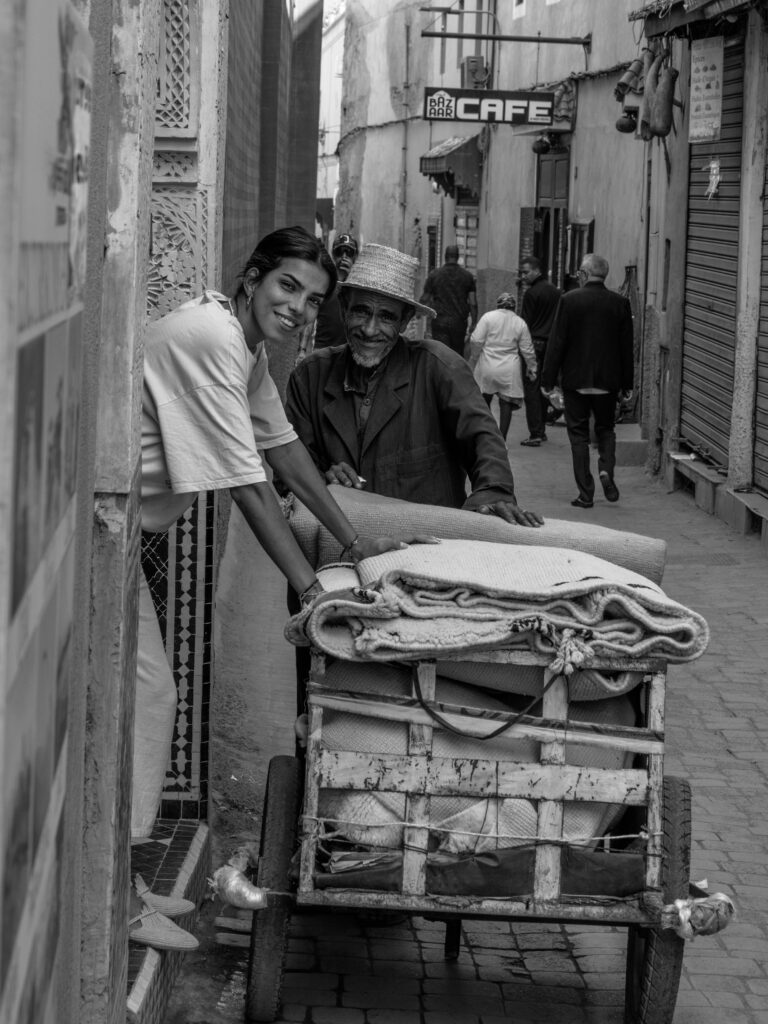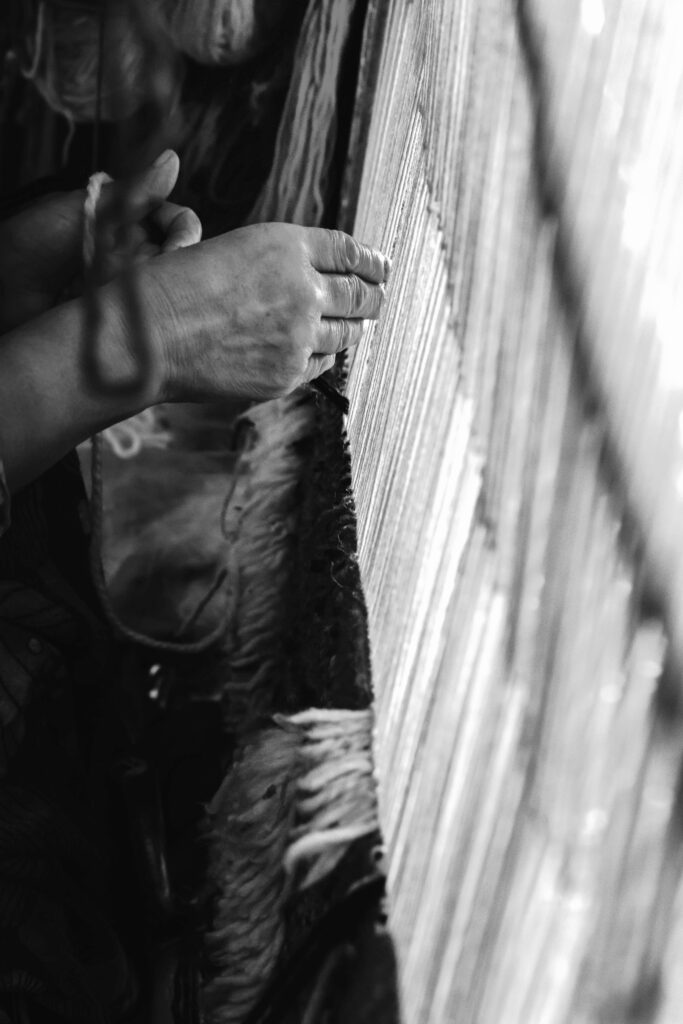Laila Fadaoui created her first limited collection to be timeless in its minimalistic approach. The original look of the M’rirt rug is elevated by innovating its design and creation process. These features will guide Fadaoui continuously. She deliberately focused on natural shades of wool, as seen in the Classic Collection. Abstract curves are incorporated to birth Mrirt’s distinguished designs. When observing the design, we quickly recognise its homage to the origin of the M’rirt rug and the celebration of the remarkable women behind its making. The unique curves honour femininity and evoke a sense of timeless elegance.
The choice of curved silhouettes reflects the limitless creativity and artistic expression of the women who have dedicated themselves to the art of rug weaving. It embodies their innovative spirit and ability to transform traditional techniques into contemporary masterpieces.
The endless rows that hold the rug in place, using an advanced knotting technique further developed by MRIRT, capture the chain of generations and the infinity of tradition itself. The organic shape of the rug holds profound symbolism; it represents unity, wholeness and the cyclical nature of life. This form is a tribute to the interconnectedness of generations, as the wisdom and skills of the past are passed down to the women who continue the legacy of rug making.
In a thoughtful gesture, these exceptional rugs will always be limited to a numbered run of eleven pieces. The number eleven symbolises new beginnings and creations. Each rug series represent a fresh start, a journey into uncharted territories, and a testament to the resilience and unwavering spirit of the women who create these works of art.
Through its design, each rug radiates ancient energy, connecting the present to the rich history and cultural heritage that shaped the M’rirt region. The intricate patterns and chosen shades reflect the stories of generations, the strength of traditions and the beauty of Moroccan artistry.
Nestled in the breathtaking Middle Atlas Mountains of Morocco, the village of M’rirt is an idyllic retreat where the art of rug weaving flourishes. It is a place where nature’s raw beauty intertwines with the meticulous artisanship that defines MRIRT rugs.
The subdued neutral colours of Mrirt rugs emanate a sense of purity and harmony. Inspired by the earthy tones of the Middle Atlas Mountains, these rugs mirror the gentle hues of sand, stone, and sun-kissed landscapes. Each thread, spun from hand-sorted natural wool, embodies the rustic beauty and warmth of the region.
MRIRT sources only the finest Beni Guile wool fibres, known for their softness, durability and inherent beauty. The wool tips used for weaving are exposed to sunlight which is an important element in the creation of MRIRT rugs and enhances the exceptional quality of the wool. The sheared wool is washed and spun in the traditional process, which prepares it for the knotting ritual. Each step of the production process is carefully overseen to maintain the highest standards of excellence. Our commitment to quality ensures a luxurious and comfortable underfoot experience.
The union of Swiss innovation and Moroccan savoir-faire is the foundation of our concept.
What makes the Mrirt rug unique?
Made in Morocco
We are committed to only use Moroccan resources. Therefore each of our rugs is handknotted with 100% Moroccan high quality sheep wool from the Central Atlas Mountains.
Quality
In addition to the quality of the materials and execution, it is the spiritual aspect of and energy that exudes from each piece that makes our rugs exceptional. Each MRIRT rug is unique and made especially for you by master weavers.
Sustainability
Due to its origin and the quality of our production, a MRIRT rug will increase in value and is, therefore, a long-term investment and a timeless piece of art.
History
MRIRT rugs are handmade according to the ancient knotting techniques of the Zayane tribes, who originated in the Middle Atlas regions. This beautiful nomadic tradition has been passed down through centuries to us, and now on to your home.
Our collection
According to tradition, rugs from the region of M’rirt are made specifically for one person to be given as a gift. To preserve this history and guarantee the quality and origin of each rug, MRIRT will begin production of a piece only when the customer is sincerely interested. This allows us to remain sustainable, effective and always innovative. Our Classic Collection is based on historical designs and will always be available for order. Our original designs are released as numbered series of eleven pieces. Of each limited-release series, one piece will remain with MRIRT as we create a living archive.
Purchasing a MRIRT rug supports the preservation of traditional artisanship and empowers the talented artisans who bring these rugs to life, contributing to the sustainability of their communities and the continuation of their heritage. All while acquiring a stunning work of art.
When you bring a MRIRT rug into your home, you invite the essence of the Middle Atlas Mountains inside, each step on its plush surface connects you to the rustic landscapes and the serene spirit of M’rirt. The simplicity of its palette and the intricacy of its craftsmanship blend seamlessly, creating a timeless masterpiece that celebrates the beauty of nature.
Immerse yourself in the tranquil beauty of M’rirt, where artisans transform natural wool into captivating rugs that reflect the landscape. Experience the harmony between the Middle Atlas Mountains and human creativity and embrace the elegance and serenity that only a MRIRT rug can provide.
Mythologie
There is something mystical about the knotting ritual. It is believed that each rug holds a blessing that flows through the hands of the weaver into the rug, purifying the energy of the household where it is placed. This nomadic tradition’s roots can be traced back to 2200 years ago.
A Maalema (the master weaver), is an Amazigh woman who traditionally would also be a Wachma (a traditionally tattooed woman whose hands are bestowed with blessings) and is able to weave an original rug in accordance with tradition. The rug is supposed to protect the person receiving the blessing, or the interior in which it is placed, from negative energies. To make the rug, the Maalema would process the wool from her own sheep and use the shearing ritual to transform the wool to be ready for weaving.


No men are allowed to enter the room during the knotting process. Only when a piece is finished and after getting permission from the Maalema, is a man called up and allowed to receive the rug. Traditionally, the man would give the Maalema a small fee for the blessing. During the knotting ritual, only the Maalema who started the knotting ritual is allowed to finish it. According to myth, she would throw a pinch of salt over the knotting machine to pause the ritual when needed in order to protect it from demons that might take over the rug in her absence.
The weaving patterns of the Zayane (Amazigh tribe in the Middle Atlas) are an execution of pure instinct. The patterns used are elements based on the weavers’ personal experiences, from natural events such as floods and droughts to life experiences such as birth, womanhood, fertility, life on the land, spirituality and faith. The unique history of each weaver makes every rug rich in stories and significance and its completion is seen as a rite of passage, thus, Amazigh women preserve their technical heritage and knowledge by passing on the messages in wool from one generation to the next, creating textiles full of life and history.
The symbolism of the Amazigh tradition is often referred to as a bridge between this world and another, meaning that the pattern and spirit of the work extend beyond its physical boundaries. They communicate with the modern world through a visual language of dark diamonds on ivory white. Wool rugs are simply the medium people have used to express themselves for centuries.
The Amazigh woman
Women play a central role in Amazigh culture. The myth of Kahina is one of many tales that has been passed on through generations.
The icon Kahina is portrayed as a figure of political and religious authority, an Amazigh queen and warrior who defended her people and land against Arab invasion and overcame the male monopoly on military enterprise, thereby becoming a legend and the only uncrowned king’s daughter in Moroccan history.
Kahina’s spirit is still very much alive and is to this day a symbol for Amazigh youth of their language and culture. Her courage has been used as inspiration, especially by young women in recent decades, to defend the right to personal freedoms and self-determination, to create space for themselves, to act in defiance of patriarchal constraints and to take control of their own destinies.
Above all, women in Amazigh culture are the artists. Amazigh women express themselves through weaving rugs, making textiles, and with body tattoos decorating their faces, hands and feet. These feminine practices have been carried out for thousands of years. It is well known that visual expression predates any form of written record. The shapes, colours and meanings of the artistic expressions of Amazigh women tell powerful stories.

